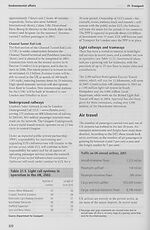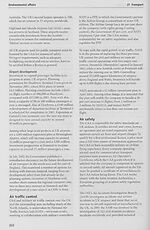Download files
Complete book:
Individual page:
Thumbnail gallery: Grid view | List view

Environmental affairs
21 Transport
low-cost or ‘no-frills’ airlines have become
increasingly popular. Day-to-day responsibility for
the regulation of civil aviation rests with the Civil
Aviation Authority (CAA - www.caa.co.uk).
The terrorist attacks in the United States on
11 September 2001 had an impact on air travel in
the UK. However, figures suggest that this was less
severe than was originally feared; for example,
passenger numbers in the fourth quarter of 2001
were down only 7 per cent on the same period in
2000. Long-haul, especially transatlantic, services
were worst hit, but short-haul European and
domestic services, especially among low-cost
carriers, have proved more resilient. The attacks
prompted a working group, comprising DfT, the
Home Office, Metropolitan Police, HM Customs
and HM Immigration, to examine security at
airports. The recommendations in the group’s
report were subsequently accepted by the
Government. Measures implemented by May 2002
included stiffer regulations concerning security
passes and the extension of counter-terrorism
checks on staff. In the longer term, enhanced CCTV
coverage will also be introduced at airports and the
co-operation and co-ordination of those involved in
airport security will be improved. The working
group will continue to meet to review progress.
operations was £8.3 billion, and the British
Airways group carried over 40 million passengers
on its fleet of 360 planes, achieving an occupancy
of 70 per cent on its main scheduled services. The
airline’s worldwide network covers 244
destinations in 97 countries, and its main
operating bases are London’s Heathrow and
Gatwick airports.
British Airways was one of the founders, together
with American Airlines, Canadian International
Airlines, Cathay Pacific and Qantas, of the
‘Oneworld’ alliance. The alliance now has eight
member airlines and serves 571 scheduled
destinations in 135 countries or territories.
Other UK Airlines
BMI, formerly British Midland, is the second
largest scheduled carrier and operates an extensive
network of scheduled services with 57 aircraft,
carrying 6.7 million passengers in 2001. Britannia
Airways is the world’s biggest charter airline and
carried 7.9 million passengers in 2001 on its
31 aircraft. Virgin Atlantic operates scheduled
services to 21 overseas destinations with 34
aircraft. Low-fare ‘no-frills’ airlines operating in
the UK include easyjet and Go; easyjet acquired
Go in August 2002.
Airlines
British Airways
British Airways is the world’s largest international
airline. During 2001/02 its turnover from airline
Table 21.6 Passenger traffic at the
UK's main airports1
1991
Million passengers
1996 2001
London Heathrow
London Gatwick
Manchester
London Stansted
Birmingham
Glasgow
London Luton
Edinburgh
Belfast International
Newcastle
Aberdeen
East Midlands
40.2
18.7
10.1
1.7
3.2
4.2
2.0
2.3
2.2
1.5
2.0
1.1
55.7
24.1
14.5
4.8
5.4
5.5
2.4
3.8
2.4
2.4
2.3
1.8
60.4
31.1
19.1
13.6
7.7
7.2
6.5
6.0
3.6
3.4
2.5
2.4
1 Terminal passengers, excluding those in transit.
Source: Civil Aviation Authority
Airports
Of the 150 or so licensed civil aerodromes in the
UK, nearly a quarter handle more than 100,000
passengers a year each. In 2001 the UK’s civil
airports handled a total of 182.3 million
passengers (181.2 million terminal passengers and
1.1 million in transit), and 2.1 million tonnes of
freight.
Heathrow is the world’s busiest airport for
international travellers and is the UK’s most
important for passengers and air freight, handling
60.4 million passengers (excluding those in
transit) and 1.2 million tonnes of freight in 2001.
Gatwick is the world’s sixth busiest international
airport and has the world’s busiest single runway.
Stansted is the fastest growing airport in Europe,
with terminal passengers increasing by 15 per cent
in 2001.
Ownership and control
BAA pic is the world’s largest commercial operator
of airports. It handles almost 200 million
passengers a year worldwide, 122 million in its
seven UK airports alone. Overseas, BAA manages
all or part of 11 airports, including six in
321
21 Transport
low-cost or ‘no-frills’ airlines have become
increasingly popular. Day-to-day responsibility for
the regulation of civil aviation rests with the Civil
Aviation Authority (CAA - www.caa.co.uk).
The terrorist attacks in the United States on
11 September 2001 had an impact on air travel in
the UK. However, figures suggest that this was less
severe than was originally feared; for example,
passenger numbers in the fourth quarter of 2001
were down only 7 per cent on the same period in
2000. Long-haul, especially transatlantic, services
were worst hit, but short-haul European and
domestic services, especially among low-cost
carriers, have proved more resilient. The attacks
prompted a working group, comprising DfT, the
Home Office, Metropolitan Police, HM Customs
and HM Immigration, to examine security at
airports. The recommendations in the group’s
report were subsequently accepted by the
Government. Measures implemented by May 2002
included stiffer regulations concerning security
passes and the extension of counter-terrorism
checks on staff. In the longer term, enhanced CCTV
coverage will also be introduced at airports and the
co-operation and co-ordination of those involved in
airport security will be improved. The working
group will continue to meet to review progress.
operations was £8.3 billion, and the British
Airways group carried over 40 million passengers
on its fleet of 360 planes, achieving an occupancy
of 70 per cent on its main scheduled services. The
airline’s worldwide network covers 244
destinations in 97 countries, and its main
operating bases are London’s Heathrow and
Gatwick airports.
British Airways was one of the founders, together
with American Airlines, Canadian International
Airlines, Cathay Pacific and Qantas, of the
‘Oneworld’ alliance. The alliance now has eight
member airlines and serves 571 scheduled
destinations in 135 countries or territories.
Other UK Airlines
BMI, formerly British Midland, is the second
largest scheduled carrier and operates an extensive
network of scheduled services with 57 aircraft,
carrying 6.7 million passengers in 2001. Britannia
Airways is the world’s biggest charter airline and
carried 7.9 million passengers in 2001 on its
31 aircraft. Virgin Atlantic operates scheduled
services to 21 overseas destinations with 34
aircraft. Low-fare ‘no-frills’ airlines operating in
the UK include easyjet and Go; easyjet acquired
Go in August 2002.
Airlines
British Airways
British Airways is the world’s largest international
airline. During 2001/02 its turnover from airline
Table 21.6 Passenger traffic at the
UK's main airports1
1991
Million passengers
1996 2001
London Heathrow
London Gatwick
Manchester
London Stansted
Birmingham
Glasgow
London Luton
Edinburgh
Belfast International
Newcastle
Aberdeen
East Midlands
40.2
18.7
10.1
1.7
3.2
4.2
2.0
2.3
2.2
1.5
2.0
1.1
55.7
24.1
14.5
4.8
5.4
5.5
2.4
3.8
2.4
2.4
2.3
1.8
60.4
31.1
19.1
13.6
7.7
7.2
6.5
6.0
3.6
3.4
2.5
2.4
1 Terminal passengers, excluding those in transit.
Source: Civil Aviation Authority
Airports
Of the 150 or so licensed civil aerodromes in the
UK, nearly a quarter handle more than 100,000
passengers a year each. In 2001 the UK’s civil
airports handled a total of 182.3 million
passengers (181.2 million terminal passengers and
1.1 million in transit), and 2.1 million tonnes of
freight.
Heathrow is the world’s busiest airport for
international travellers and is the UK’s most
important for passengers and air freight, handling
60.4 million passengers (excluding those in
transit) and 1.2 million tonnes of freight in 2001.
Gatwick is the world’s sixth busiest international
airport and has the world’s busiest single runway.
Stansted is the fastest growing airport in Europe,
with terminal passengers increasing by 15 per cent
in 2001.
Ownership and control
BAA pic is the world’s largest commercial operator
of airports. It handles almost 200 million
passengers a year worldwide, 122 million in its
seven UK airports alone. Overseas, BAA manages
all or part of 11 airports, including six in
321
Set display mode to:
![]() Universal Viewer |
Universal Viewer | ![]() Mirador |
Large image | Transcription
Mirador |
Large image | Transcription
The item on this page appears courtesy of Office for National Statistics and may be re-used under the Open Government Licence for Public Sector Information.
| Britain and UK handbooks > UK: The official yearbook of the United Kingdom of Great Britain and Northern Ireland > 2003 > (359) |
|---|
| Permanent URL | https://digital.nls.uk/204927777 |
|---|
| Attribution and copyright: |
|
|---|---|
| Description | Three volumes of 'UK: The official yearbook of the United Kingdom of Great Britain and Northern Ireland', published annually by the Office of National Statistics from 2002-2005. |
|---|---|
| Shelfmark | GII.11 SER |
| Description | Three titles produced by the British Government from 1954-2005 describing 'how Britain worked'. They are: 'Britain: An official handbook' (1954-1998), 'Britain: The official yearbook of the United Kingdom' (1999-2001), and 'UK: The official yearbook of the United Kingdom of Great Britain and Northern Ireland' (2002-2005). These 50 reports provide an overview of Britain's economic, social and cultural affairs, its environment, international relations, and the systems of government. They give an impartial summary of government policies and initiatives, and explain how public services are organised. |
|---|---|
| Additional NLS resources: |
|

